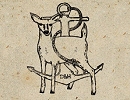Contact Seller
Doe And Hope
Tel07729 213013Please quote Antiques Atlas.


 1645 Engraved Map of Warwickshire, Worcestershire
1645 Engraved Map of Warwickshire, Worcestershire
 1645 Copper Engraved Map of Leicestershire
1645 Copper Engraved Map of Leicestershire
 1880 Large Coloured District Railway Map of London
1880 Large Coloured District Railway Map of London
 1620 Original John Speed Map of Flintshire
1620 Original John Speed Map of Flintshire
 1620 Original John Speed Map of Herefordshire
1620 Original John Speed Map of Herefordshire
 AMERICAN 1952 NOVEMBER PIN UP CALENDAR GIRL Vintag
AMERICAN 1952 NOVEMBER PIN UP CALENDAR GIRL Vintag
 Original Pin Up 1952 August American Calendar Girl
Original Pin Up 1952 August American Calendar Girl
 PIN UP APRIL 1949 CALENDAR ORIGINAL Al Moore
PIN UP APRIL 1949 CALENDAR ORIGINAL Al Moore
 1949 MARCH ORIGINAL PINUP CALENDAR GIRL Al Moore
1949 MARCH ORIGINAL PINUP CALENDAR GIRL Al Moore
 American Vintage 1949 February Al Moore Pin Up
American Vintage 1949 February Al Moore Pin Up
 George Petty Original 1947 November Calendar Girl
George Petty Original 1947 November Calendar Girl
 19thc illuminated page after William Morris
19thc illuminated page after William Morris
Non UK callers :
+44 7729 213013
Architect’s Site Plan for Northumberland Asylum


The large and scarce architects site plan, framed and glazed, inscribed ‘John Gepwell (?)a.3.c.e. Grunty(?) Architect 17.Dec 1888’’, showing the plan of the ground floor of the Northumberland Lunatic Asylum, with an array of interesting rooms and new wings added, surviving from the late Victorian period.
There is some expected light discoloration to the page edges in places but largely the whole remains in tact so this only serves in adding some more character. There are fold creases and two tears as photographed. The frame is contemporary and effective.
The construction of asylums was widespread in Britain following The Lunacy Act of 1845, which resulted primarily from the work of John Connolly and Lord Shaftsbury. This act professionalised the asylum, and ensured that each institution was mediated by the local authority. It marked a paradigmatic shift, wherein ‘lunatics’ began to be considered as patients instead of prisoners.
The Northumberland County Pauper Lunatic Asylum opened on 16 March 1859. Lunatic Asylums were managed by Committees of Visitors appointed by the Quarter Sessions under the Lunacy Act 1845 and were subject to visits by the Commissioners in Lunacy. Situated in Cottingwood, Morpeth, the asylum was a magnificent Victorian building built in the Italian style of red brick with stone dressings. Designed by Henry Welsh, it was originally built to accommodate about 200 male and female patients. In 1890 the asylum was renamed the County Mental Hospital then in 1937 the name was changed to St. George’s Hospital. In 2006 St Georges Park, a purpose built mental health hospital was built on the old St. George’s site.
The apartments on the west side were for female inmates while males were situated on the east. Surrounding the buildings were pleasure and kitchen gardens as well as a stone chapel and brewery. The Superintendent was the principal officer of the asylum and was required to be a medical practitioner and legally qualified. The Matron was responsible for all female attendants, servants and female patients and the Clerk/Steward for male patients and male staff.
During the day patients of both sexes were employed. Men worked in the garden and were taught trades by Shoemakers, Tailors, Plumbers and Painters. The women worked in the laundry and kitchen and also undertook sewing, knitting and mending work. Reading was encouraged and an ample supply of books and publications of a moral and cheerful nature had to be made available. This was in addition to the bible and prayer books.
The Asylum Rule Book stated the following:
“There be at least one attendant for every ward and that there be not less than one attendant for every 25 patients who are tranquil or convalescent and not less than one attendant for every 12 patients who are dirty, violent, refractory or dangerous to themselves or others. No ward shall be left at any time without an attendant being there and that the attendant be so distributed that in case of need they may readily assist each other.”
When this plan was drawn up in 1888, as additional hospital buildings were being built, the population of the asylum had risen to 267 men and 244 women and in 1890 the Asylum was renamed the County Mental Hospital. The plan shows rooms such as ‘Dead House’, ‘Post Mortem Room’, ‘Shoemakers Shop’ and ‘Ashes’ to name but a few.
A hugely interesting and important piece of social history and possibly the only surviving example of its type.
SellerDoe And Hope
View all stock from
Doe And Hope

 Private dealer, By appointment only
Private dealer, By appointment only
The Onion Barn, Shoe Cottage,
15 High Street, Blunham,
Bedfordshire, MK44 3NL.
MK44 3NL
Tel : 07729 213013
Non UK callers : +44 7729 213013
Get directions to Doe And Hope
There is some expected light discoloration to the page edges in places but largely the whole remains in tact so this only serves in adding some more character. There are fold creases and two tears as photographed. The frame is contemporary and effective.
The construction of asylums was widespread in Britain following The Lunacy Act of 1845, which resulted primarily from the work of John Connolly and Lord Shaftsbury. This act professionalised the asylum, and ensured that each institution was mediated by the local authority. It marked a paradigmatic shift, wherein ‘lunatics’ began to be considered as patients instead of prisoners.
The Northumberland County Pauper Lunatic Asylum opened on 16 March 1859. Lunatic Asylums were managed by Committees of Visitors appointed by the Quarter Sessions under the Lunacy Act 1845 and were subject to visits by the Commissioners in Lunacy. Situated in Cottingwood, Morpeth, the asylum was a magnificent Victorian building built in the Italian style of red brick with stone dressings. Designed by Henry Welsh, it was originally built to accommodate about 200 male and female patients. In 1890 the asylum was renamed the County Mental Hospital then in 1937 the name was changed to St. George’s Hospital. In 2006 St Georges Park, a purpose built mental health hospital was built on the old St. George’s site.
The apartments on the west side were for female inmates while males were situated on the east. Surrounding the buildings were pleasure and kitchen gardens as well as a stone chapel and brewery. The Superintendent was the principal officer of the asylum and was required to be a medical practitioner and legally qualified. The Matron was responsible for all female attendants, servants and female patients and the Clerk/Steward for male patients and male staff.
During the day patients of both sexes were employed. Men worked in the garden and were taught trades by Shoemakers, Tailors, Plumbers and Painters. The women worked in the laundry and kitchen and also undertook sewing, knitting and mending work. Reading was encouraged and an ample supply of books and publications of a moral and cheerful nature had to be made available. This was in addition to the bible and prayer books.
The Asylum Rule Book stated the following:
“There be at least one attendant for every ward and that there be not less than one attendant for every 25 patients who are tranquil or convalescent and not less than one attendant for every 12 patients who are dirty, violent, refractory or dangerous to themselves or others. No ward shall be left at any time without an attendant being there and that the attendant be so distributed that in case of need they may readily assist each other.”
When this plan was drawn up in 1888, as additional hospital buildings were being built, the population of the asylum had risen to 267 men and 244 women and in 1890 the Asylum was renamed the County Mental Hospital. The plan shows rooms such as ‘Dead House’, ‘Post Mortem Room’, ‘Shoemakers Shop’ and ‘Ashes’ to name but a few.
A hugely interesting and important piece of social history and possibly the only surviving example of its type.
Price The price has been listed in British Pounds.
Conversion rates as of 25/JUN/2025. Euro & Dollar prices will vary and should only be used as a guide.
Always confirm final price with dealer. Phone or visit the website to buy, Free UK shipping.
Category Antique Ephemera
Date c.1888
Late Victorian Antiques Material Paper
Origin English
Item code as155a1852 / 1930
Status Sold
£550.00 
$749.32 
€644.82 

$

€

Conversion rates as of 25/JUN/2025. Euro & Dollar prices will vary and should only be used as a guide.
Always confirm final price with dealer. Phone or visit the website to buy, Free UK shipping.
View all stock from
Doe And Hope

 Private dealer, By appointment only
Private dealer, By appointment onlyThe Onion Barn, Shoe Cottage,
15 High Street, Blunham,
Bedfordshire, MK44 3NL.
MK44 3NL
Tel : 07729 213013
Non UK callers : +44 7729 213013
Get directions to Doe And Hope
You may also be interested in
 1645 Engraved Map of Warwickshire, Worcestershire
1645 Engraved Map of Warwickshire, Worcestershire
 1645 Copper Engraved Map of Leicestershire
1645 Copper Engraved Map of Leicestershire
 1880 Large Coloured District Railway Map of London
1880 Large Coloured District Railway Map of London
 1620 Original John Speed Map of Flintshire
1620 Original John Speed Map of Flintshire
 1620 Original John Speed Map of Herefordshire
1620 Original John Speed Map of Herefordshire
 AMERICAN 1952 NOVEMBER PIN UP CALENDAR GIRL Vintag
AMERICAN 1952 NOVEMBER PIN UP CALENDAR GIRL Vintag
 Original Pin Up 1952 August American Calendar Girl
Original Pin Up 1952 August American Calendar Girl
 PIN UP APRIL 1949 CALENDAR ORIGINAL Al Moore
PIN UP APRIL 1949 CALENDAR ORIGINAL Al Moore
 1949 MARCH ORIGINAL PINUP CALENDAR GIRL Al Moore
1949 MARCH ORIGINAL PINUP CALENDAR GIRL Al Moore
 American Vintage 1949 February Al Moore Pin Up
American Vintage 1949 February Al Moore Pin Up
 George Petty Original 1947 November Calendar Girl
George Petty Original 1947 November Calendar Girl
 19thc illuminated page after William Morris
19thc illuminated page after William Morris







